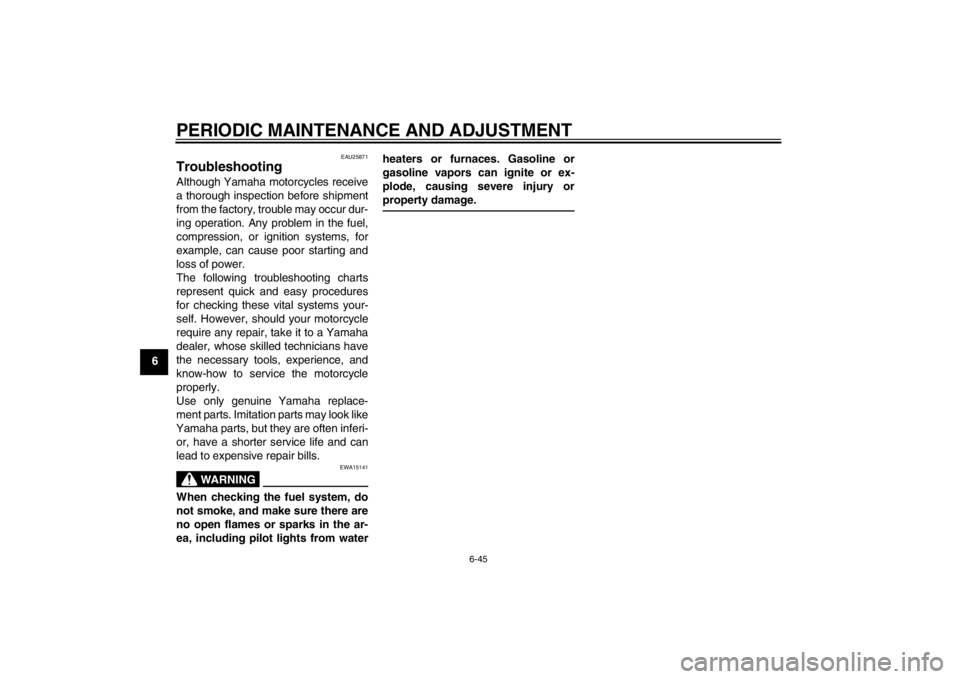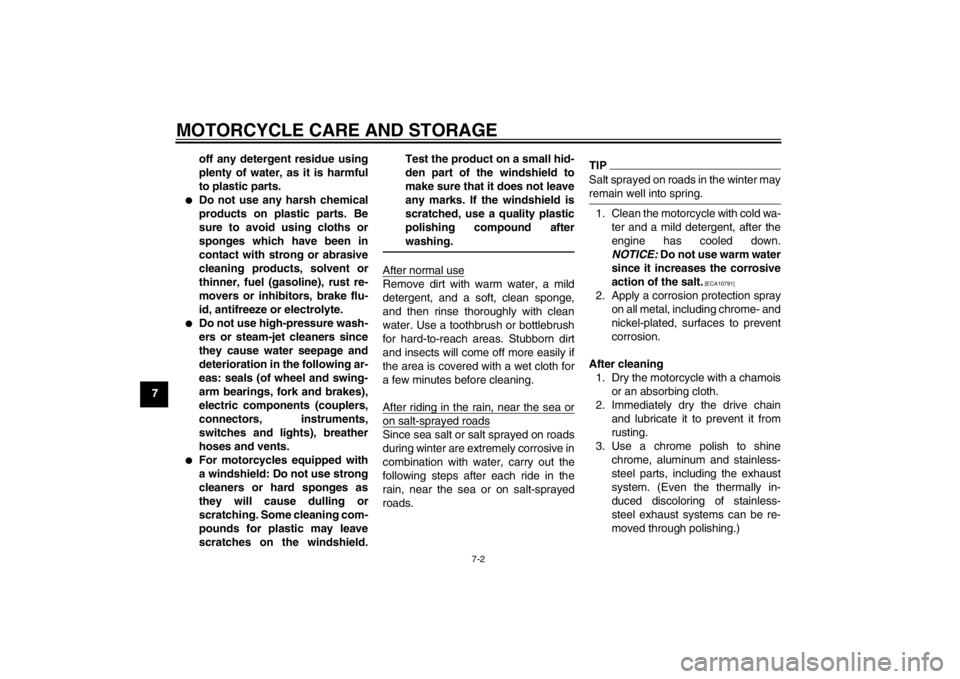lights YAMAHA XJ6-N 2010 User Guide
[x] Cancel search | Manufacturer: YAMAHA, Model Year: 2010, Model line: XJ6-N, Model: YAMAHA XJ6-N 2010Pages: 104, PDF Size: 2.86 MB
Page 51 of 104

PERIODIC MAINTENANCE AND ADJUSTMENT
6-6
6
19*Front fork Check operation and for oil leak-
age. √√√√
20 *Shock absorber as-
sembly Check operation and shock ab-
sorber for oil leakage. √√√√
21 Engine oil Change.
Check oil level and vehicle for oil
leakage. √√√√√√
22 Engine oil filter car-
tridge Replace.
√√√
23 *Cooling system Check coolant level and vehicle
for coolant leakage. √√√√√
Change with ethylene glycol anti- freeze coolant. Every 3 years
24 *Front and rear brake
switches Check operation.
√√√√√√
25 Moving parts and
cables
Lubricate.
√√√√√
26 *Throttle grip Check operation.
Check throttle grip free play, and
adjust if necessary.
Lubricate cable and grip housing. √√√√√
27 *Lights, signals and
switches Check operation.
Adjust headlight beam.
√√√√√√
NO. ITEM CHECK OR MAINTENANCE JOB
ODOMETER READING
ANNUAL
CHECK
1000 km
(600 mi) 10000 km
(6000 mi) 20000 km
(12000 mi) 30000 km
(18000 mi) 40000 km
(24000 mi)
U20SE3E0.book Page 6 Monday, April 23, 2012 10:47 AM
Page 90 of 104

PERIODIC MAINTENANCE AND ADJUSTMENT
6-45
6
EAU25871
Troubleshooting Although Yamaha motorcycles receive
a thorough inspection before shipment
from the factory, trouble may occur dur-
ing operation. Any problem in the fuel,
compression, or ignition systems, for
example, can cause poor starting and
loss of power.
The following troubleshooting charts
represent quick and easy procedures
for checking these vital systems your-
self. However, should your motorcycle
require any repair, take it to a Yamaha
dealer, whose skilled technicians have
the necessary tools, experience, and
know-how to service the motorcycle
properly.
Use only genuine Yamaha replace-
ment parts. Imitation parts may look like
Yamaha parts, but they are often inferi- or, have a shorter service life and can
lead to expensive repair bills.
WARNING
EWA15141
When checking the fuel system, do
not smoke, and make sure there are
no open flames or sparks in the ar-
ea, including pilot lights from water heaters or furnaces. Gasoline or
gasoline vapors can ignite or ex-
plode, causing severe injury or
property damage.U20SE3E0.book Page 45 Monday, April 23, 2012 10:47 AM
Page 94 of 104

MOTORCYCLE CARE AND STORAGE
7-2
7off any detergent residue using
plenty of water, as it is harmful
to plastic parts.
●
Do not use any harsh chemical
products on plastic parts. Be
sure to avoid using cloths or
sponges which have been in
contact with strong or abrasive
cleaning products, solvent or
thinner, fuel (gasoline), rust re-
movers or inhibitors, brake flu-
id, antifreeze or electrolyte.
●
Do not use high-pressure wash-
ers or steam-jet cleaners since
they cause water seepage and
deterioration in the following ar-
eas: seals (of wheel and swing-
arm bearings, fork and brakes),
electric components (couplers,
connectors, instruments,
switches and lights), breather
hoses and vents.
●
For motorcycles equipped with
a windshield: Do not use strong
cleaners or hard sponges as
they will cause dulling or
scratching. Some cleaning com-
pounds for plastic may leave
scratches on the windshield. Test the product on a small hid-
den part of the windshield to
make sure that it does not leave
any marks. If the windshield is
scratched, use a quality plastic
polishing compound after
washing.
After normal useRemove dirt with warm water, a mild
detergent, and a soft, clean sponge,
and then rinse thoroughly with clean
water. Use a toothbrush or bottlebrush
for hard-to-reach areas. Stubborn dirt
and insects will come off more easily if
the area is covered with a wet cloth for
a few minutes before cleaning.
After riding in the rain, near the sea oron salt-sprayed roadsSince sea salt or salt sprayed on roads
during winter are extremely corrosive in
combination with water, carry out the
following steps after each ride in the
rain, near the sea or on salt-sprayed
roads.
TIPSalt sprayed on roads in the winter may
remain well into spring.1. Clean the motorcycle with cold wa-
ter and a mild detergent, after the
engine has cooled down.
NOTICE: Do not use warm water
since it increases the corrosive
action of the salt.
[ECA10791]
2. Apply a corrosion protection spray on all metal, including chrome- and
nickel-plated, surfaces to prevent
corrosion.
After cleaning 1. Dry the motorcycle with a chamois or an absorbing cloth.
2. Immediately dry the drive chain and lubricate it to prevent it from
rusting.
3. Use a chrome polish to shine chrome, aluminum and stainless-
steel parts, including the exhaust
system. (Even the thermally in-
duced discoloring of stainless-
steel exhaust systems can be re-
moved through polishing.)
U20SE3E0.book Page 2 Monday, April 23, 2012 10:47 AM
Page 101 of 104

INDEX
AABS (for ABS models) .......................... 3-14
ABS warning light (for ABS models) ....... 3-7
Air filter element, replacing ................... 6-17
Auxiliary light bulb, replacing ................ 6-40BBattery .................................................. 6-33
Brake and clutch levers, checking and lubricating ..................... 6-30
Brake and shift pedals, checking and lubricating ..................... 6-29
Brake fluid, changing ............................ 6-26
Brake fluid level, checking .................... 6-25
Brake lever ........................................... 3-13
Brake lever free play, checking ............ 6-23
Brake light switches (for ABS models) ................................ 6-24
Brake light switches
(for non-ABS models) ......................... 6-24
Brake pedal .......................................... 3-14CCables, checking and lubricating .......... 6-29
Care ........................................................ 7-1
Catalytic converter ................................ 3-17
Clutch lever........................................... 3-13
Clutch lever free play, adjusting ........... 6-22
Coolant ................................................. 6-13
Coolant temperature warning light.......... 3-4
Cowling and panels,
removing and installing......................... 6-8DDimmer switch ...................................... 3-12
Drive chain, cleaning and lubricating .... 6-28
Drive chain slack .................................. 6-27
EEngine break-in .......................................5-3
Engine idling speed ...............................6-18
Engine oil and oil filter cartridge ............ 6-10
Engine stop switch ................................ 3-12
Engine trouble warning light .................... 3-7FFront and rear brake pads, checking .... 6-24
Front fork, checking...............................6-31
Fuel ....................................................... 3-16
Fuel consumption, tips for reducing ........ 5-3
Fuel tank breather hose and overflow hose ...................................... 3-17
Fuel tank cap......................................... 3-15
Fuses, replacing .................................... 6-34HHandlebar position, adjusting ................ 3-20
Handlebar switches ............................... 3-11
Hazard switch........................................ 3-12
Headlight bulb, replacing....................... 6-36
Helmet holder ........................................ 3-18
High beam indicator light......................... 3-4
Horn switch ........................................... 3-12IIdentification numbers ............................. 9-1
Ignition circuit cut-off system ................. 3-22
Immobilizer system .................................3-1
Immobilizer system indicator light ........... 3-7
Indicator lights and warning lights ........... 3-4LLicense plate light bulb, replacing ......... 6-40MMain switch/steering lock ........................ 3-2
Maintenance and lubrication, periodic..... 6-4 Maintenance, emission control system ... 6-3
Matte color, caution ................................ 7-1
Model label ............................................. 9-1
Multi-function meter unit ......................... 3-8
NNeutral indicator light .............................. 3-4OOil level warning light .............................. 3-4PParking.................................................... 5-4
Part locations .......................................... 2-1
Pass switch ........................................... 3-12SSafety information ................................... 1-1
Seat ...................................................... 3-18
Shifting .................................................... 5-2
Shift pedal ............................................. 3-13
Shock absorber assembly, adjusting .... 3-20
Sidestand .............................................. 3-21
Sidestand, checking and lubricating ..... 6-31
Spark plugs, checking............................. 6-9
Specifications.......................................... 8-1
Starting the engine.................................. 5-1
Start switch ........................................... 3-12
Steering, checking ................................ 6-32
Storage ................................................... 7-3
Storage compartment ........................... 3-19
Supporting the motorcycle .................... 6-41
Swingarm pivots, lubricating ................. 6-31TTail/brake light bulb, replacing .............. 6-38
Throttle grip and cable,
checking and lubricating ..................... 6-29
Throttle grip free play, checking............ 6-19
U20SE3E0.book Page 1 Monday, April 23, 2012 10:47 AM